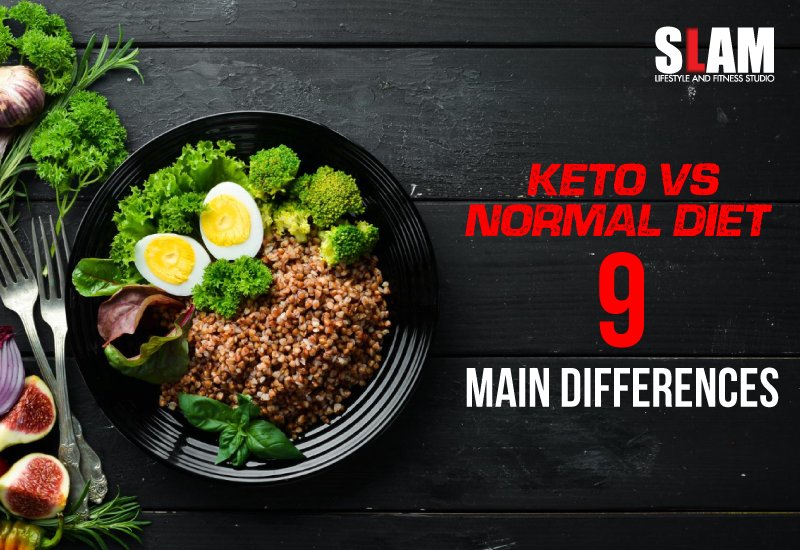Introduction to the Keto Diet & Normal Diet
A keto diet, known as a ketogenic diet, is a high-fat and low-carbohydrate diet that aims to shift the body into a metabolic state called ketosis. In ketosis, the body uses fats to burn energy instead of carbohydrates.
The keto diet includes high-fat sources like fatty meats, butter, and oils, low carbohydrates like leafy greens, and small amounts of proteins like fish and eggs. Whole grains, fruits and many processes foods are generally avoided on a keto diet.
A normal diet is also known as a balanced diet with all foods in appropriate proportions, thus providing the nutrients necessary for optimal health and well-being. The normal diet includes all fruits, vegetables, whole grains, proteins, dairy and fats that provide the necessary nutrients for the body to function efficiently.
Apart from the diet, physical activity plays a crucial role if you want to be fit, lose or gain weight. Visit SLAM Fitness today to start your fitness journey!
| Do you know? The Keto diet originated in the 1920s to treat epilepsy in children! Later, research studies found it beneficial for diabetes and neurological conditions. |
9 Differences between the Keto Diet and the Normal Diet
The professional trainers of SLAM Fitness list the top 9 differences in the battle between the keto vs normal diet.
| Sl.No | Difference | Keto Diet | Normal Diet |
| 1 | Macronutrient ratios | High fat, low carb and moderate protein: The Keto diet involves a macronutrient of approximately 70% fat, 25% protein and 5% carbohydrates. | Moderate fat, moderate carb and moderate protein: The normal diet involves a macronutrient of 45 to 60% carbohydrates, 20-35% of fat, and 10-35% protein approximately. |
| 2 | Carbohydrate intake | Less than 50g per day: The typical keto diet includes a carbohydrate intake of 20 to 50 grams daily. | Varies depending on the individual goals: However, typically, one can consume 200 to 300 grams of carbohydrates daily. |
| 3 | Fat intake | High: The keto diet comprises high fat intake, typically 70-80% of total calorie intake, consuming healthy fats such as avocados, nuts, seeds and oil. | Moderate: The normal diet comprises moderate fat intake, typically 20-30% of total calorie intake from various sources, including animal products, nuts and oils. |
| 4 | Protein intake | Moderate: The keto diet comprises moderate protein intake, typically 20% of total calorie intake, consuming meat, poultry, fish, eggs, etc. | Moderate: The normal diet comprises moderate protein intake, typically 20-30% of total calorie intake from various sources, including beans, legumes, tofu, etc. |
| 5 | Ketosis | Burns fat for energy: The keto diet achieves a state of ketosis, where the body uses fat as an alternative fuel source. | Burns glucose for energy: The normal diet uses glucose from carbohydrates as a fuel source. |
| 6 | Weight loss | Short-term weight loss: The keto diet promotes weight loss, particularly in the short term. It is because of the increase in fat intake and restriction in carbohydrates. | Weight loss combined with calorie deficit: The normal diet leads to weight loss when combined with a calorie deficit. |
| 7 | Nutrient density | Low: Though the keto diet provides essential nutrients, it is comparatively low since it is restricted. | Wide range of nutrients: Since the normal diet is balanced, it meets an individual’s nutrient needs. |
| 8 | Sustainability | Difficult: The keto diet restricts food choices. Hence it is difficult to follow the diet for the long term. | Long-term: The normal diet is sustainable for the long term if a balanced approach is taken. |
| 9 | Health risk | Prevalence of chances: Health risks such as nutrient deficiencies, constipation, and increased risk of heart disease can occur if the majority of the fats are consumed from unhealthy sources. | Prevalence of chances: A normal diet reduces the risk of nutrient deficiencies and other health issues. |
When no diets are followed, and unhealthy foods are consumed in the long run, it can increase the chance of chronic diseases. Hence it is crucial to consult a healthcare professional to follow a diet and stay fit.
Pros of the Keto Diet
Let’s see the advantages of a keto diet that help you make an informed decision about your eating habits.
Benefits
- It helps in weight loss- As the keto diet includes strict restrictions for carbohydrates, it helps in short-term weight loss that gives visible and speedy results.
- It improves metabolic health- The keto diet has shown results to improve insulin sensitivity, lower blood sugar levels and reduce the risk of type 2 diabetes, thus fostering good metabolic health.
- It increases energy levels- Since the keto diet achieves the state of ketosis, the body uses fat to burn energy as an alternative fuel source. Thus it increases energy levels and provides mental clarity while following the diet.
- It reduces appetite- The keto diet reduces the appetite, making you feel less hungry, thus restricting the calorie intake and making it easier to stick to the diet and helping in the weight loss process.
- It has potential therapeutic benefits- The keto diet is found beneficial in conditions such as epilepsy, Parkinson’s disease, and certain types of cancer and brain tumours.
Pros of the Normal Diet
Let’s see the advantages of a normal diet that help you make an informed decision about your eating habits.
Benefits
F
- You get essential nutrients- A balanced diet includes whole food from all food groups, thus providing the essential nutrients required for optimal health and well-being. It has carbohydrates, proteins, fats, vitamins, and minerals.
- It is flexible and sustainable- A balanced diet is not restrictive or difficult to follow. Hence, it has been sustainable for a long time. One can tailor the foods according to their preferences and needs, as plenty of options exist.
- It helps maintain weight- It helps maintain a healthy weight since the diet comprises whole grains and nutrient-dense foods, thus reducing the risk of chronic diseases such as heart disease, diabetes and obesity.
- Improves digestion- Since the balanced diet includes fibre-rich foods such as fruits, vegetables, whole grains and legumes, it aids in better digestion, thus improving gut health.
- Supports mental health- Studies state that nutrient-dense foods support mental health and well-being by reducing inflammation and enhancing brain function, thus lowering the risk of depression and anxiety.
Cons of the Keto and the Normal Diets
There is always the other side to the coin and the keto and normal diets too have their disadvantages.
Drawbacks of the keto diet
- Individuals might find it challenging to adhere to the keto diet for the long term because of the restricted carbohydrate intake and limited food choices, making it difficult to achieve a balanced intake of nutrients.
- The keto diet doesn’t provide many nutrients to the body, particularly fibre, because of the restriction to eating fruits, whole grains and vegetables.
At SLAM Fitness, the professional trainers give you a workable keto diet plan to meet the required nutrients for your body and achieve your weight loss goal.
Downsides of the normal diet
- A balanced diet requires intense planning and preparation, which everyone might not find easy. It is challenging for those with busy schedules as it can be time-consuming.
- It requires strict discipline and moderation in food choices, portion sizes and frequency of meals, thus making it difficult for individuals to adapt to unhealthy eating habits.
- The normal diet won’t be suitable for individuals with medical conditions or dietary restrictions since it follows intaking a balanced meal of all foods.
- Unlike other fancy diets, normal diets won’t provide quick results, and they should be followed consistently for the long term for visible outcomes.
- Since it includes the consumption of nutrient-rich food on a daily basis, it can be expensive for individuals with limited financial resources.
Choose SLAM FITNESS for the overall well-being of your health!
SLAM Fitness is a valuable resource for individuals looking to improve their physical fitness and health. Its professional trainers ensure that their clients meet their personal preferences and goals. Their services include functional training, fitness boot camp, body transformation, weight loss, weight gain and more.
Their workout plans are perfect for long-lasting fitness results and a healthy lifestyle. Their vast equipment, such as weightlifting, cardiovascular machines, group fitness classes, personal training services, etc., helps you achieve your fitness goals. SLAM Fitness also provides additional services, such as nutrition counselling and wellness programs, considering people’s overall well-being.
If you want to reduce your weight or gain muscles, opt for workout sessions with the personal trainers from SLAM Fitness and stay fit and healthy!
Conclusion
The ketogenic diet can be more restrictive and challenging because of the significant reduction in carbohydrate intake that can lead to nutrient deficiencies. It may not be sustainable in the long term for everyone.
On the other hand, you can achieve your desired results with a balanced diet and a great extent of patience. And it is also to be noted that it cannot show drastic results as a keto diet in meeting your weight loss requirements.
Both diets have pros and cons, wrapping up keto vs normal diet. Consult a nutritionist before following the best approach to your specific needs and goals.
FAQs
1). Is keto better for weight loss?
The keto diet can promote weight loss by making the body rely on fats for fuel and restricting carbohydrates. While there is evidence that the ketogenic diet helps people lose weight, it entirely depends on the factors like age, gender, activity level, and overall health.
2). Does keto burns belly fat?
The ketogenic diet may help reduce belly fat by burning fat for energy, including that stored in the abdominal area. However, it depends on several factors, including the individual’s calorie intake, physical activity level, genetics, etc.
3). Is keto better than a regular diet?
Though the keto diet is effective in aiding weight loss since it is a high-fat and low-carbohydrate diet, it can be challenging in the long run, making it unsuitable for everyone. A regular diet encompasses various eating patterns and may or may not be effective for weight loss.
4). Is keto the healthiest way to eat?
If not planned carefully, the ketogenic diet may result in the risk of nutrition deficiencies. Though it aids in weight loss and improves blood sugar and cholesterol levels, a balanced diet of whole foods, including fruits, vegetables, lean proteins, healthy fats, etc., is the most beneficial way to eat.
5). What are the basic rules for keto?
Ketogenic is a restricted diet that should consist of 60-80% fat, 10-30% protein and not more than 5-10% or 20-50% grams of carbs per day. Drinking plenty of water and monitoring the ketone levels are necessary.



